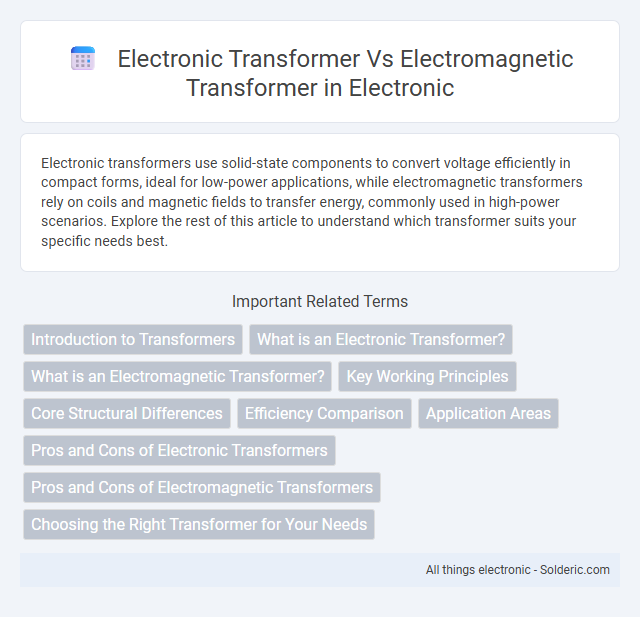Electronic transformers use solid-state components to convert voltage efficiently in compact forms, ideal for low-power applications, while electromagnetic transformers rely on coils and magnetic fields to transfer energy, commonly used in high-power scenarios. Explore the rest of this article to understand which transformer suits your specific needs best.
Comparison Table
| Feature | Electronic Transformer | Electromagnetic Transformer |
|---|---|---|
| Operating Principle | Uses electronic circuitry and high-frequency switching | Relies on electromagnetic induction with iron core |
| Frequency | High frequency (20 kHz to several MHz) | Low frequency (50/60 Hz) |
| Size and Weight | Compact and lightweight | Large and heavy due to iron core |
| Efficiency | Higher efficiency at high frequency | Generally efficient at low frequency |
| Heat Generation | Lower heat generation due to efficient switching | Higher heat due to core losses |
| Noise | Minimal noise, mostly silent operation | Audible hum caused by magnetostriction |
| Application | Used in LED lighting, power supplies, electronic devices | Used in power grids, audio equipment, industrial machinery |
| Cost | Generally more expensive due to complex circuitry | Lower cost and widely available |
Introduction to Transformers
Transformers are essential devices in electrical engineering, designed to transfer electrical energy between circuits through electromagnetic induction. Electronic transformers leverage high-frequency switching technology to achieve compact size and high efficiency, ideal for low-power applications such as LED lighting. In contrast, electromagnetic transformers use traditional iron cores and operate at main power frequency, delivering robust performance for high-voltage power transmission and industrial uses.
What is an Electronic Transformer?
An electronic transformer is a compact, lightweight device that uses high-frequency electronic circuitry to convert electrical energy, offering improved efficiency and reduced size compared to traditional electromagnetic transformers. It operates by switching the input voltage at high frequencies, enabling smaller magnetic components and lower power losses. Commonly used in low-voltage lighting systems and electronic devices, electronic transformers provide precise voltage regulation and enhanced performance in modern electrical applications.
What is an Electromagnetic Transformer?
An electromagnetic transformer is a device that transfers electrical energy between two or more circuits through electromagnetic induction, typically consisting of primary and secondary coils wound around a magnetic core. It operates on alternating current (AC) to step voltage up or down, ensuring efficient power transmission in electrical systems. Unlike electronic transformers, electromagnetic transformers rely on magnetic flux and coil windings without integrated semiconductor components.
Key Working Principles
Electronic transformers operate by rapidly switching electrical current through semiconductor components, converting voltage via high-frequency electromagnetic fields in compact circuits. Electromagnetic transformers rely on the principle of electromagnetic induction, using copper coils wrapped around a magnetic core to transfer energy between circuits through varying magnetic flux. Your choice depends on the required frequency, efficiency, size, and application needs, as electronic transformers excel in low power, high-frequency scenarios, while electromagnetic transformers are robust for traditional power distribution.
Core Structural Differences
Electronic transformers utilize ferrite cores with high-frequency operation, enabling smaller size and lighter weight compared to electromagnetic transformers that rely on laminated silicon steel cores for low-frequency AC power. The ferrite core in electronic transformers minimizes eddy current losses at high frequencies, while electromagnetic transformers require iron cores to efficiently conduct magnetic flux at 50/60 Hz. Structural differences also affect thermal performance; electronic transformers, with compact ferrite cores and printed circuit-based windings, dissipate heat differently than the bulkier iron-core electromagnetic transformers.
Efficiency Comparison
Electronic transformers generally offer higher efficiency than electromagnetic transformers due to their ability to operate at higher frequencies, reducing core losses and allowing for smaller, lighter components. Electromagnetic transformers, relying on traditional iron cores and low-frequency AC, typically experience greater energy losses from hysteresis and eddy currents. Optimizing Your power systems with electronic transformers can result in significant energy savings and improved performance.
Application Areas
Electronic transformers are primarily used in low-power applications such as LED lighting, photovoltaic systems, and electronic devices requiring voltage regulation and compact size. Electromagnetic transformers dominate in high-power applications like power distribution, industrial machinery, and electrical grids due to their robust construction and efficiency in handling high voltages and currents. The choice between electronic and electromagnetic transformers depends on application-specific requirements for frequency range, efficiency, and physical size.
Pros and Cons of Electronic Transformers
Electronic transformers offer advantages such as compact size, high energy efficiency, and reduced heat generation compared to electromagnetic transformers. They provide precise voltage regulation and are ideal for low-power applications, particularly in LED lighting systems. However, electronic transformers may suffer from electromagnetic interference, limited durability under high loads, and higher initial costs relative to traditional electromagnetic transformers.
Pros and Cons of Electromagnetic Transformers
Electromagnetic transformers offer high efficiency and reliable power transfer with minimal energy loss, making them ideal for high-voltage applications and electrical isolation. They are robust and simple in design, ensuring long service life and low maintenance costs; however, their bulky size and heavy weight limit portability and installation in compact spaces. Electromagnetic transformers can produce audible noise and generate heat, requiring proper cooling and insulation to maintain performance and safety.
Choosing the Right Transformer for Your Needs
Electronic transformers offer compact design, high efficiency, and lightweight construction, making them ideal for low-voltage lighting and modern electronic devices. Electromagnetic transformers provide robust performance, better suited for high-power applications and those requiring isolation between circuits. Evaluate your power requirements, space constraints, and application type to select the right transformer that optimizes energy use and ensures reliable operation.
electronic transformer vs electromagnetic transformer Infographic

 solderic.com
solderic.com